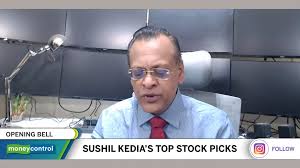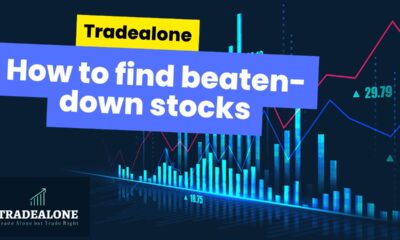Editor
Market Uncertainty, AI Disruption & Investment Wisdom: A Conversation with Sushil Kedia

In a volatile market where indices fluctuate between 23,800 and 21,800, investors are often left confused. To decode the signals from the Indian and global markets, we sat down with seasoned market expert Sushil Kedia (Founder at Kedianomics). In this deeply insightful and candid conversation, Sushil Kedia unpacks the layers of volatility, shares his macro and micro market view, and gives out invaluable advice for every type of investor.
“The market is trying to confuse both the buyer and the seller.”
Kedia starts by highlighting how the market is currently in a phase where no one seems to be happy. “The buyer might suffer less, but the seller can get completely trapped,” he points out. Nifty has swung from 23,800 to 21,800 and is now on a path back upward. “We are possibly heading to 24,200, or even 25,000, but be ready for another shock.” He warns of sharp dips of 500-600 points on Nifty and even steeper corrections on Bank Nifty.
Time Frame Matters
Kedia emphasizes the importance of analyzing markets in multiple dimensions: indices, sectors, and timeframes. “Don’t just focus on index levels. There are sectors and specific stocks that are setting up for strong moves,” he says. While broader markets might remain range-bound, there are pockets of opportunity.
Bank Nifty & Sector Views
“Bank Nifty has shown a supernormal thrust, but that might not sustain,” warns Kedia. According to him, private banks like ICICI and Kotak are forming bull traps. On the flip side, he suggests, “Federal Bank is a buy today. There’s still life in some PSU and small finance banks.”
He is cautious on sectors like metals and cement, saying there’s still downside left. “IT might be bottoming out soon,” he notes. Large-cap IT stocks could give delivery-based buy signals in the coming week.
Top Picks Across Sectors
- Pharma: Sun Pharma, Dr. Reddy’s, and Pfizer are on Kedia’s radar. “Pfizer looks ready to explode upward.”
- Engineering: “Larsen & Toubro is a firm buy on dips. Cummins and Siemens will take a little more time.”
- Auto Components: MRF, Seat, Bosch, and Sundaram Brake Lining are forming strong bottoms. “Ricco Auto and Automotive Axles also look promising.”
- Real Estate: “Prestige, Embassy, and DLF are already on a buy signal for delivery investors.”
He makes it clear: “Pick and choose. Don’t try to buy everything.”
“Work with discipline. This is not the time for leverage or MTF trading.”
Kedia emphasizes risk management over and over. “Delivery buying, no leverage, no margin trading,” he advises. In a fearful market, he believes the safest bets are stocks with consistent earnings visibility.
FMCG and Consumption Plays: These will act as safe havens. “In fear, PE ratio becomes irrelevant. What matters is earnings visibility,” says Kedia.
Gold: Overheated and Vulnerable
Despite gold being a traditional safe asset, Kedia remains cautious. “Gold is overbought, hyper-volatile, and due for a major correction,” he warns. He is not ready to go long until a proper reversal chart pattern forms.
On US Markets and Global Cues
“Every major global crisis has been followed by a wild bull run,” he reminds us. According to Kedia, investors who stay calm and accumulate during these volatile phases end up with disproportionate rewards later. “Look at Covid: portfolios created in that panic created wealth.”
Key Takeaways for Investors
- Be cautious in the short term but prepare to accumulate.
- Don’t depend solely on indices. Moreover, keep looking at stock-specific opportunities.
- Avoid leverage. Stick to delivery-based investments.
- Consumption, IT, and select pharma and real estate stocks are in early uptrends.
- Understand your financial needs: “How much is enough?”
Final Words
“You can’t wait until you’re 70 to look back and regret not trying what your heart wanted,” says Kedia as he closes the conversation. For him, discipline, clarity, and knowing your own priorities matter more than chasing market highs.
This conversation wasn’t just about market predictions, but about building a deeper understanding of how to invest smartly, live consciously, and know when to pause, reflect, and pivot.
Stay curious. Stay disciplined. And above all, stay invested wisely.
Checkout dynamic Trendlines for all the Indian Stocks at Tradealone: Click here.
Editor
How to Make Money After the 2025 Market Crash
Learn how to build regular income from dividend investing after the 2025 market crash. A beginner-friendly guide for Indian investors using real-world strategies and relatable stories.

Introduction: When Markets Crash and Hearts Panic
After the 2025 market crash, a wave of uncertainty swept across Indian investors. Some said, “You should’ve stuck with FDs.” Others asked, “How do I earn regular income in this chaos?” For many, the crash wasn’t just about numbers going down—it was about dreams shattering and fear rising. So let’s cut through the noise and get to something solid.
Yes, the stock market will rise in the long term—but in the short term, you want stability. You want Rs. 10,000, Rs. 20,000, or even Rs. 1 lakh coming in monthly without selling your stocks. Is that even possible? Absolutely. And the answer lies in dividend investing. This blog will walk you through what dividends are, how they work, and how you can use them to build passive income—even after a crash.
1. Dividend Income: The Rent of the Stock Market
Everyone knows about stock appreciation—buy at Rs100, sell at Rs120, pocket the Rs20. Simple. But here’s a lesser-known gem: dividends. Just like a house gives you rent, a good stock can give you regular payouts called dividends.
When a company earns profit, it can either reinvest or share a portion with its shareholders. This is the dividend—usually announced per share. If Wipro declares a Rs. 5 dividend and you own 100 shares, you earn Rs. 500. You didn’t sell anything, but you earned something.
In short, dividends = regular income from stocks, even without trading. This is why dividend investing is gaining traction in uncertain times like post-2025.
2. Choose Wisely: Not Every Stock Pays
Let’s be clear—not every company gives dividends. Startups like Paytm or Zomato may prioritize growth over payouts. Meanwhile, established players like Wipro, ICICI Bank, or BPCL offer regular dividends—often even during market dips.
Here’s what you should check when picking dividend stocks:
- Profitability: No profits, no dividends.
- Dividend history: Look for consistent payouts over 3–5 years.
- Dividend yield: Aim for 1–4% annually. High yields (above 6–7%) could be unsustainable.
- Payout ratio: Ideally between 30–60% of net profits.
- Ex-dividend date: Buy the stock before this date to qualify for the dividend.
You don’t need to memorize these. Tools like Screener.in or Groww offer dividend data clearly.
3. Let’s Talk Numbers: What Rs. 1 Lakh/Month Looks Like
Let’s say your average dividend yield is 1.5%. To earn Rs. 1 lakh per month = Rs. 12 lakh per year post-tax. But remember—dividends are taxed as per your income slab. So, gross income needs to be around Rs. 18 lakh (assuming 30–33% tax).
Now divide Rs. 18 lakh by 1.5%. That’s a whopping Rs. 12 crore portfolio!
Too much? Start small. Even with a Rs. 5 lakh dividend portfolio, you’ll earn around Rs. 7,500 annually. Reinvest this, add fresh capital, and repeat. Over time, this snowballs into a powerful income machine.
4. How to Start Dividend Investing in 2025
Start slow, start steady. Here’s a practical plan:
- Start with Rs. 5,000 or Rs. 10,000 per month SIP into dividend-paying stocks or mutual funds.
- Reinvest all dividend income into the same or new dividend stocks.
- Pick a mix of large caps (Wipro, Infosys), mid caps (Castrol, ITC), and a few small caps cautiously.
- Use platforms like Smallcase to explore readymade dividend portfolios.
- Monitor dividend history and payout ratios annually. Adjust allocations every year based on performance.
As your salary or business income increases, scale up your investments. This is the most underrated form of passive income out there.
5. The Perfect Blend: Safety + Growth + Yield
Here’s a model asset allocation for a dividend income portfolio:
- 50–60% in blue-chip dividend stocks: Infosys, ICICI Bank, HDFC
- 20–30% in mid-cap dividend stocks: Castrol, PFC, REC
- 10–20% in high-yield stocks: BPCL, Coal India (carefully monitor sustainability)
This balance gives you steady income (from blue-chips), some growth (from mid-caps), and a yield boost (from high yielders).
Don’t forget—dividend investing is not about short-term returns. It’s a retirement game plan. The more patient you are, the more reliable your monthly income becomes.
Conclusion: Build Wealth, One Rupee at a Time
After a crash, it’s easy to panic. FDs seem safer, and yes—they’re stable. But they won’t make you rich. Dividend investing is your ticket to long-term wealth and short-term peace of mind.
By carefully picking solid companies, reinvesting dividends, and staying consistent, you can build a portfolio that supports your lifestyle—without selling your assets. Think of it as rent from your stock market “real estate.” You’re not just investing in stocks; you’re investing in freedom.
So, if you’re wondering what to do after 2025—here’s your answer: Build your dividend income portfolio. Start now. Grow slowly. Let compound magic do the rest.
Explore Dividend Smallcases like “Dividend Aristocrats” or “High Dividend Yield + Capital Appreciation” for easy setups with consistent returns.
Editor
Why Wealth Explodes After ₹1 Crore: Breaking the 1 Cr to 10 Cr Barrier
Find out why wealth grows exponentially after hitting ₹1 crore and how you can go from 0 to 1 Cr and then to 10 Cr using smart strategies and mindset shifts.

Introduction: The Magic of ₹1 Crore
Have you ever noticed that hitting your first Rs1 crore feels almost impossible, but after that, wealth seems to multiply on its own? It’s not a coincidence. Wealth creation is not linear — it’s exponential. The real game begins after that first big milestone. And in this blog, we’ll uncover exactly why wealth explodes after ₹1 crore and how you can plan your journey — from 0 to Rs1 crore and then from Rs1 crore to Rs10 crore.
We’ll walk you through mindset shifts, investment strategies, real-life calculators, and habits that work in India — whether you’re earning Rs50,000 a month or more. Plus, we’ll show how small consistent actions beat big one-time efforts when it comes to compounding.
Main Content
1. Why Wealth Creation Feels Slow — Until It Doesn’t
Imagine you’re doing a SIP of Rs10,000/month with a 12% annual return. Here’s what it looks like:
- After 10 years: Rs23.3 lakhs
- After 15 years: Rs50 lakhs
- After 20 years: Rs1 crore
Now here’s the magic — the second crore takes just 5 more years. The third one? 3 years. The next? 2 years. The fifth crore in just over 1 year. Every new crore takes less time.
This is the power of compounding. The first Rs1 crore takes decades. But once that engine builds, the wealth machine accelerates. That’s why half the battle is building up to Rs1 crore — the rest happens faster than you think.
2. Building Your Safety Net Before You Grow
Before you think about crores, you need to secure your base. Because if an emergency strikes, your entire investment journey gets disrupted. Here’s how to build your safety net:
- Emergency Fund: 6–12 months of monthly expenses in a liquid account. If you spend Rs 20,000/month, save Rs1.2–2.4 lakhs for emergencies like job loss or hospital bills.
- Health Insurance: Don’t rely only on corporate insurance. With medical inflation at 11% per year, having ₹5–10 lakhs individual cover is essential.
- Life Insurance: A pure term insurance plan — not ULIP or endowment — ensures your family is protected if something happens to you.
This foundation is what allows you to take risks. Without it, you live in constant fear, which affects how and when you invest.
3. Start Investing Early and Often (Even Small Amounts)
Don’t wait to earn ₹1 lakh/month to start investing. Start with whatever you can. The goal is not just returns — it’s building the habit. Aim for investing at least 20% of your income.
Example: If your salary is Rs50,000/month, try to invest Rs10,000 — through SIPs in mutual funds, index funds, or ETFs. The earlier you start, the more time compounding gets.
And don’t forget:
- Choose Direct mutual fund plans if you invest yourself — they charge lower fees.
- If you prefer advice, regular plans are fine — just know the difference.
A 1% difference in fees over 20 years can cost you over Rs20 lakhs. Compounding works in reverse too — when costs are high, your gains are lower.
4. Avoid Lifestyle Inflation
We all know about inflation — things becoming expensive. But the real problem is lifestyle inflation — upgrading your life every time your salary increases.
Here’s what that looks like:
- From budget shoes to branded sneakers
- From shared flat to luxury studio apartment
- From Zomato on weekends to dining out every day
It’s not wrong to enjoy life. But if you upgrade every time your salary increases, you’ll never invest. The money will vanish, and your dream of hitting Rs1 crore will keep moving further away.
Solution: The moment your salary comes, move 20% into SIPs. Put another 10% into a fun/luxury account (with no debit card). What remains in your account is what you spend — you’ll automatically adjust your life to that amount.
5. Stop Anti-Compounding — Avoid Debt
We all talk about investing at 12% CAGR. But credit cards charge 36–40% interest annually. That’s reverse compounding. You’re not growing money — you’re losing it fast.
Many people spend months paying EMIs and credit card bills for things they don’t even use anymore. So ask yourself: Do you own your iPhone or does it own you?
From car loans to EMIs on furniture — avoid unnecessary debt. Sure, some debt like a home loan may be planned. But personal loans for weddings or gadgets? That’s lifestyle debt — and it delays your wealth creation goals significantly.
Bonus: Who Are You Earning For?
Think of it this way:
- You work 2–3 months for the government (taxes)
- You work another 2–3 months for the bank (EMIs)
- The remaining few months are what you actually earn for yourself
If most of your salary goes into debt repayment, you’re working for everyone except yourself. Break this chain early in your career and you’ll hit Rs1 crore faster.
Conclusion: From ₹0 to ₹1 Crore — And Beyond
Hitting ₹1 crore is a game changer. It’s slow, painful, and takes discipline. But once you cross that milestone, compounding kicks in, and ₹1 crore to ₹10 crore becomes a realistic goal.
Here’s how to approach it:
- Secure your base — Emergency fund, life, and health insurance
- Start early — Invest consistently, even small amounts
- Control lifestyle — Don’t upgrade with every raise
- Stay out of bad debt — Avoid anti-compounding
Build a system that works even when you’re not watching. Wealth isn’t just built with skills — it’s built with mindset and habits. And once you cross that Rs1 crore, you’ll see the magic unfold faster than you ever imagined.
Want to start your journey to Rs1 crore? Here are some useful links:
Editor
Why a ₹15 Lakh Salary Can Secretly Make You Poor – A Deep Dive with Ankur Warikoo
Discover how a ₹15 lakh salary may not bring financial freedom. Learn why lifestyle inflation, societal pressure, and poor money habits can trap you.

Introduction: The Dream Salary Illusion
For many young Indians, the idea of earning ₹15 lakh per year sounds like a dream. It’s that magic number we’re told to chase after college or early in our careers. Your relatives smile, your LinkedIn lights up, and friends whisper — “You’ve made it.” But let’s pause. What if I told you that hitting ₹15 lakh could quietly be the beginning of a trap?
This isn’t just another lecture on saving or investing. This is about the mental shift that happens when money starts flowing in. Inspired by a brutally honest talk by Ankur Warikoo, this article takes you on a journey of what really happens when your dream salary arrives. And spoiler alert — it’s not all roses.
Main Content
1. The Salary That Changes Everything — Or Does It?
Let’s say you finally get the ₹15 lakh per annum package. Roughly ₹1.2 lakh per month after taxes. On the surface, that’s brilliant! You feel confident. You start thinking about moving out, upgrading your phone, maybe even planning your next vacation.
But society starts reacting. Your parents say, “Beta, time to settle down.” Relatives nudge, “Get your own flat now.” Friends suggest “No more PG bro, rent a 2BHK.” And slowly, expectations start rising — from everyone, including yourself.
You upgrade your life not because you really need it, but because you’re expected to. This is the first trap — societal pressure.
2. Lifestyle Inflation – The Silent Sinkhole
This is what Warikoo calls the “lifestyle sink.” Like water slipping through a drain, your income starts disappearing. You get a cook. You start weekend Swiggy orders. You move from Activa to a red car. Your clothes go from Sarojini Nagar to Zara.
- Grocery shopping becomes BigBasket + Nature’s Basket
- Clothes? Branded only
- Travel? At least once a quarter, or “we’re not living enough”
None of this is inherently wrong. But here’s the catch — it becomes normal. And when it becomes normal, your baseline expenses shoot up. You don’t feel richer anymore. Instead, you feel like you’re still catching up. Because your needs evolve into luxuries… and luxuries quietly become necessities.
3. Relationship Expenses – The Emotional Drain
Relationships change too. Birthday gifts are now Amazon vouchers or Apple Watches. Dinner dates are no longer at cafes — they’re at fine-dining restaurants with pre-booked slots. Even how you express love begins to carry a price tag.
It’s not because the other person expects it. It’s because you want to show that you’re earning ₹15 lakh. From gifts to travel to mini surprises, you start spending to compensate for time, emotions, and guilt.
Friendship dynamics change as well. You begin to avoid friends who aren’t earning as much. Why? Because now you like fancy bars over tapris. You forget that relationships once thrived on shared samosas, not on shared subscriptions.
4. When ₹15 Lakh Starts Feeling Too Small
At some point, a terrifying feeling creeps in: “Even this isn’t enough.” You want more. Maybe ₹20 lakh. Then ₹30. And in that process, you start taking EMIs — car loans, home loans, renovation loans, and worst of all — personal loans.
Your future income gets mortgaged for present desires.
One Warikoo follower said it best: “I earn ₹5 lakh per month and have zero investments.” Why? Because every rupee goes toward repaying something — a plot, a sofa, a fancy phone.
Eventually, you’re not growing richer — you’re getting trapped deeper. Trapped in a golden cage where the job is not optional anymore. You can’t take breaks. You can’t switch careers. You’re just… stuck.
5. Escape Plan: Redefine Money’s Role in Your Life
The escape? Simple but not easy. You redefine what money means. It’s not about showing status. It’s not about proving anything. It’s about freedom.
Warikoo talks about the 50-30-20 Rule — Spend 50% on needs, 30% on wants, 20% on investments. But with one twist. As you grow in your career, increase the investment share of every increment.
Let’s say you move from ₹1 lakh to ₹1.2 lakh/month. Then:
- 50% of the increment (₹10,000) → investments (₹5,000)
- 30% (₹3,000) → wants
- Only 20% (₹2,000) → lifestyle upgrades
This method ensures your “needs” don’t balloon with your income. You preserve the most valuable thing in life — choice. The choice to quit, rest, travel, or start something new.
And most importantly, understand that no amount of salary — ₹15 lakh or even ₹1 crore — can replace purpose. Ambani still works. Musk works even harder. Because it’s not about money. It’s about impact, purpose, and self-respect.
Conclusion: Choose Freedom Over Flexing
It’s easy to get caught up in the euphoria of hitting the ₹15 lakh salary milestone. It feels good. It should feel good. But remember — it’s just a tool. Not the goal. If your lifestyle grows faster than your investments, you’ll never feel rich. You’ll always feel like you’re behind.
Use your salary to buy freedom, not furniture. Invest more. Upgrade less. And define success on your own terms — not by the EMI of your SUV or the price of your next phone.
Because in the end, the real goal isn’t to earn more. It’s to need less and live more.
👉 For more financial wisdom, follow Ankur Warikoo’s blog or check out his YouTube channel.
Want personal finance updates and smart money tips? Bookmark TradeAlone Finance Blog today.
-

 defense4 months ago
defense4 months agoHAL Share Price Target 2025: Motilal Oswal Sees 27% Upside for Hindustan Aeronautics
-

 FMCG5 months ago
FMCG5 months agoThe FMCG Sector: Challenges, Opportunities, and the Rise of Quick Commerce
-

 news3 months ago
news3 months agoComputer Age Management Services (CAMS) Q4 and FY25 Results: Growth Across Segments
-
Uncategorized5 months ago
Hello world!
-

 auto5 months ago
auto5 months agoTata Motors Stock Analysis: A Roller Coaster Journey of Price Movements
-

 Editor4 months ago
Editor4 months agoSwan Energy Future Outlook 2025 | Growth in Energy, Real Estate & Shipbuilding
-

 stock market5 months ago
stock market5 months agoThe Changing Job Market and Its Impact on the Economy and Stock Market
-

 Editor5 months ago
Editor5 months ago10 Steps to find BEATEN DOWN Stocks that can BOUNCE Back


Признаки токсичных отношений.
April 29, 2025 at 8:01 pm
Личные границы создают защищенное пространство для самореализации, высвобождают творческую энергию и позволяют строить далеко идущие планы, не растрачиваясь на бесконечные
просьбы о “маленькой помощи”.
Видео. Личные границы. Забота о себе.